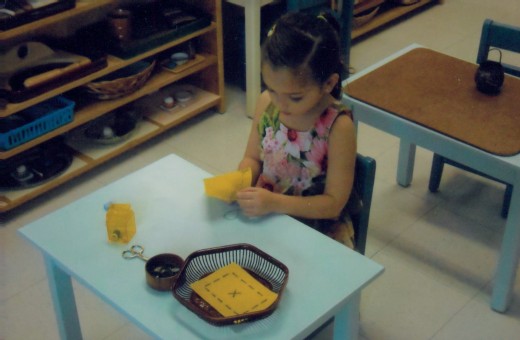An Authentic Montessori Classroom

The name “Montessori” is in the public domain, and many variations and types of centers bear Maria Montessori’s name. In 1929, she founded the Association Montessori Internationale (AMI) to protect her work and to insure it would correspond to the principles and philosophy she had formulated from her years of observation. An authentic Montessori classroom will display these characteristics:
Mixed ages / 3-year cycle
The cycles follow the planes of development and each class will have a balance of the ages in that level. For example, the Casa level is for ages three to six. Children enter after their third birthday and remain in the same class through their fifth or kindergarten year, a 3-year cycle. In a mixed age environment, the younger children learn from observing the older, the older develop leadership skills by serving as role models and helping the younger.
Freedom Within Limits
Montessori is often described where children are given complete freedom and allowed to do whatever they please, or conversely, are always directed what to do and when. Neither is accurate. There are simple guidelines which serve to maintain a positive social atmostphere. These allow children to always know what is expected and to be secure in having freedom to be active within the class.
Freedom of Choice
Having those simple guidelines allow children to move about freely, to choose activities and to work with them as long as they wish, and to associate freely with their classmates. Freedom within limits and of choice culminate in the classroom functioning as a community and become a “family.”
Uninterrupted Work Periods
When children arrive in the morning, they may wander around the room until they find an activity that attracts them, they are free to work with that activity or others until their interest is satisfied. Some children may work for long periods with an activity that has their complete attention, others may select several activities over the morning. Children may work alone, or with a self-chosen group, or join a group the adult has gathered for a special lesson. Once children are absorbed in activity, the adult does not interrupt them. Her role is to help those who need assistance or to introduce children to new activities as they are ready. Both she and the assistant spend time observing the children in their activities, which allows them to chart their progress or need for help.
Self-Esteem Born in Success
Materials on the shelves have been selected and designed to attract children that meets a developmental need appropriate for their age and readiness. At first, children may have difficulty, but they will continue to try and try, and when they have met the challenge they chose, they experience what is called “intrinsic reward”. They know it was hard, but because they persisted, they were successful and one hears, “I did it myself!” No one needs to tell them “good job” – they know it themselves. Many of these successes lead them to realizing they are competent and can do things – and of these many successes, true self-esteem is born.
The Adult’s Role
The Montessori adult is most often referred to as a teacher, a director or a guide. Our role is that of an “environmental mediator” – we are there to put the child into contact with the materials. It is as if the materials hold the concepts and information as a electric plug is the conduit to electricity. We “connect the child to the materials” as if we are connecting their brains with an activity which will develop a skill or concept necessary for their learning. We are responsible to maintain the environment with an eye to aesthetics and with materials complete and in good repair. Upon getting to know each child’s needs and personalities, we can guide him or her to activities which will promote their continued growth. Lastly, we maintain social harmony within the classroom community so that all feel secure, respected and loved. This is our command from Maria Montessori – to “follow the child.”